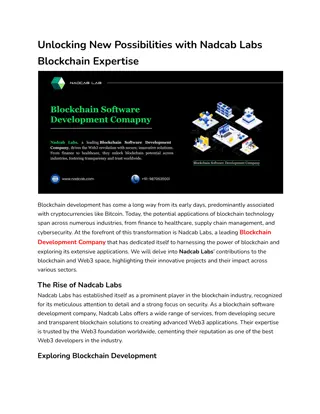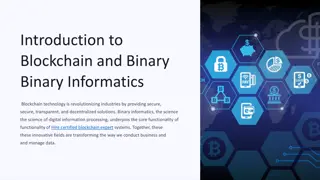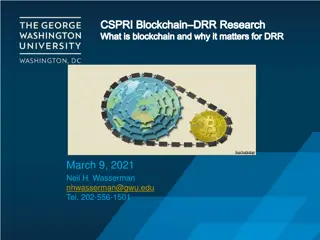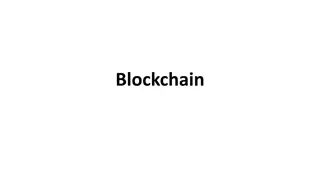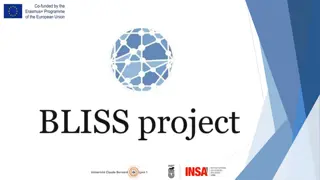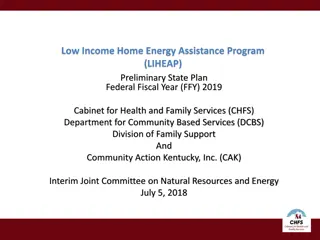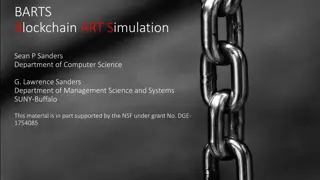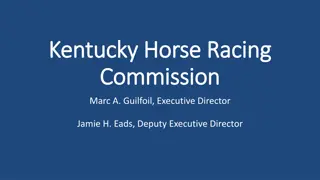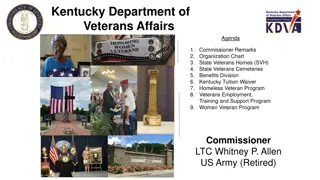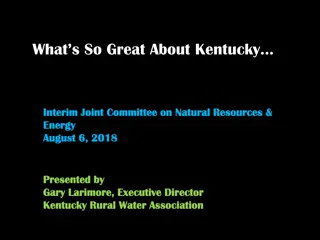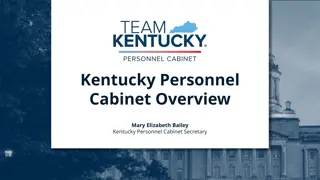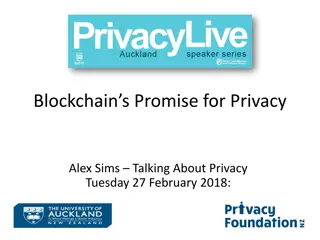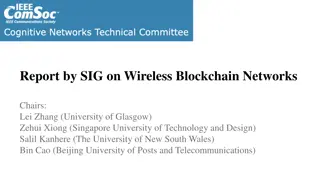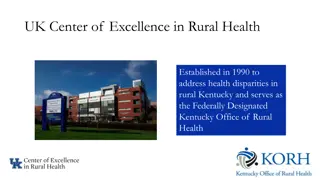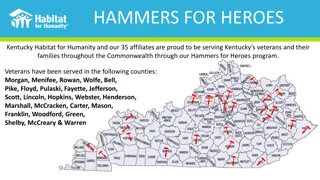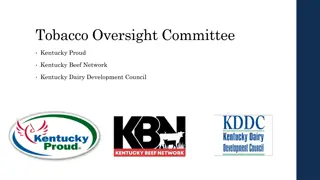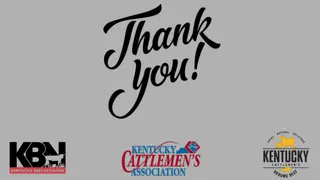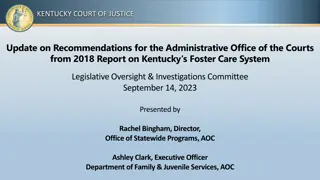Kentucky Blockchain Technology Working Group Overview
The Kentucky Blockchain Technology Working Group, established to evaluate the feasibility of blockchain technology, aims to enhance the Commonwealth by identifying adoption opportunities. With a mission to assess blockchain's efficacy in various sectors, including finance, logistics, and healthcare, the group collaborates with industry experts. The annual reports highlight use cases and potential benefits in different industries, emphasizing the significance of blockchain in secure transaction management and data sharing. Explore the potential advancements that blockchain technology can bring to Kentucky's economic landscape.
Download Presentation

Please find below an Image/Link to download the presentation.
The content on the website is provided AS IS for your information and personal use only. It may not be sold, licensed, or shared on other websites without obtaining consent from the author.If you encounter any issues during the download, it is possible that the publisher has removed the file from their server.
You are allowed to download the files provided on this website for personal or commercial use, subject to the condition that they are used lawfully. All files are the property of their respective owners.
The content on the website is provided AS IS for your information and personal use only. It may not be sold, licensed, or shared on other websites without obtaining consent from the author.
E N D
Presentation Transcript
18 Unsupervised Data Mining and Clustering Dave Eargle CU Boulder
Clustering The idea is to identify natural subgroups in data With supervised segmentation, you identify differences among data with respect to a target variable How do people who default on a loan differ from those who do not default? With unsupervised segmentation, you do no have a target variable. You are exploring your data Into what natural subgroups do my data fall? Another application of the concept of similarity Identify groups that have high intra-group similarity but low inter-group similarity
Why cluster? Imagine that you are a manufacturer of cars. Why might you want to identify different groups of customers? What kinds of groups might you identify? Imagine that you are a politician running for election. Why might you want to identify different groups of voters? What kinds of groups might you identify? With clustering (with understanding natural subgroups), you can develop: Better products Better marketing campaigns Better sales methods Better customer service
Hierarchical clustering vs Centroid-based clustering Two different ways of clustering
Hierarchical Clustering Considers individual points and the distance between them The idea is to cluster points based on some link function i.e., minimum requirement that must be met before a cluster is merged with another cluster. For the following slides, we will use the following link function: For any given pair of clusters, the Euclidian Distance between the closest two points must be smaller than some threshold in order for the clusters to be merged. The chosen threshold is arbitrary and exploratory.
Hierarchical Clustering Start with 6 points. Important! At the beginning, each point is its own cluster. So, 6 clusters. What will be the next pair of clusters to merge, as we increase the link function threshold?
5 Clusters What will be the next pair of clusters to merge, as we increase the link function threshold?
4 Clusters What will be the next pair of clusters to merge, as we increase the link function threshold?
3 Clusters What will be the next pair of clusters to merge, as we increase the link function threshold?
2 Clusters What will be the next pair of clusters to merge, as we increase the link function threshold?
1 Cluster How useful is this clustering output?
Summary of the merging steps we just did Slight error point F should be further away (true on all following slides, too). See previous slides for correct geospacing.
Dendogram another way of visualizing visualizing hierarchical clustering
Hierarchical Clustering Y-axis has our cutoff threshold metric. 6 Clusters
Time for more whiskey Let s say we run a small whiskey shop with limited space. We want to identify groups of whiskeys by taste, so that we can: stock one well-known and one lesser-known from each group of whiskeys. Or, stock one expensive and one affordable whiskey from each group etc. How might we identify taste groups of whiskeys? (Groups depending on all possible attributes of taste , shown below) Put another way, how do we identify clusters of most similar whiskeys?
Whiskey dendogram Which whiskey is the last to cluster? This is the most unusual single point.
Whiskey dendogram Which whiskey is the last to cluster? This is the most unusual single point.
Whiskey dendogram Which whiskeys are similar to Bunnahabhain?
The tree of life is a dendogram Here s one showing only species with fully-sequenced genomes as of 2006 http://itol.embl.de/itol.cgi#
Alternative: Centroid-based clustering
Hierarchical clustering vs centroid-based clustering Hierarchical clustering considers individual points and the distance between then Centroid-based clustering considers the whole group of points at once A centroid is a cluster center k-meansis a common centroid clustering algorithm each centroid is the mean of its points You decide k the number of centroids (groups) Start with the centroids in some spot (maybe random placement)
Stars are the centroids at their starting points algorithm groups the points based on which centroid they are closest to the means of the grouped values are calculated, which determines the new centroids
which moves the centroids. The whole process is repeated Points are grouped based on which centroid they are closest to, new centroids are calculated, etc. You stop the algorithm usually when the centroids stop moving around much.
Another example Let s pick k=3 again Intuitively, where would you place the centroids for k=3?
Centroids start here Centroids end up here Shapes are the final group membership based on nearest centroid
Understanding the Results of Clustering So you have your k different groups. Let s say you have dozens of dimensions. From there, how might you label the different groups? How might you describe them? One option: average dimension values (essentially the centroid) But other centroids might have the same average values for some dimensions Another option: by what makes the groups different from all other groups For this, used supervised learning to generate cluster descriptions
Supervised learning to describe cluster Here s the tree for Group J . How would you describe Group J , based on the tree? Call each cluster a class Analyze one class at a time Set the target variable for all rows to indicate whether or not (binary) it is the current class being analyzed Use something descriptive like a decision tree to predict whether it is a member of the class or not A full gold (but not red) color with a light (but not round) body and a dry finish. Whiskeys in group J are described as A round body and a sherry nose, or
How to use clustering for supervised learning? Capital One example First, use all available features and cluster all current customers to identify natural groups. What kind of customer groups might you identify, based on their credit card usage behavior? Then, use supervised learning to train a model using only the features that will be available at application time Then, use that model at application time to produce probabilities for cluster membership Viola, you have used unsupervised learning to circle back and inform supervised learning
Unsupervised learning is very fast in the earlier stages (because you often simply don t yet understand your business question or your data), but takes longer in the evaluation stage.
Many figures in this slide deck from Provost, F., & Fawcett, T. (2013). Data science for business: what you need to know about data mining and data-analytic thinking. Sebastopol, Calif.: O'Reilly.



